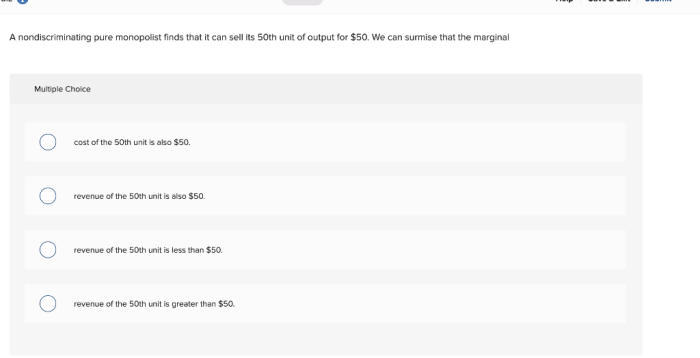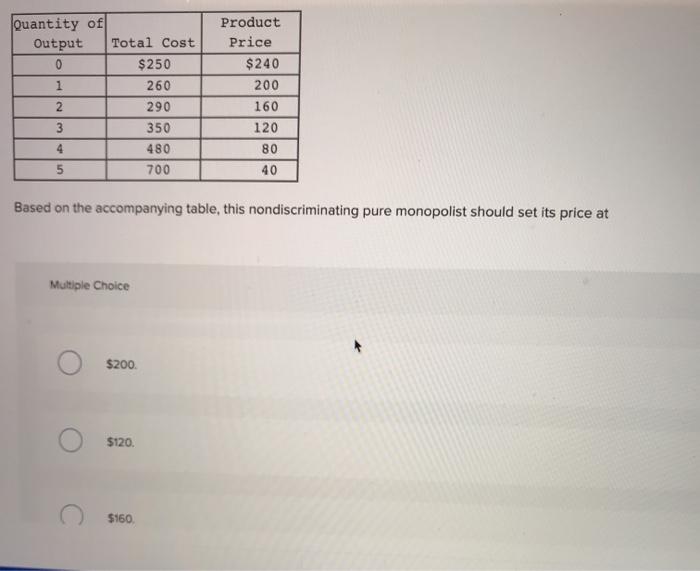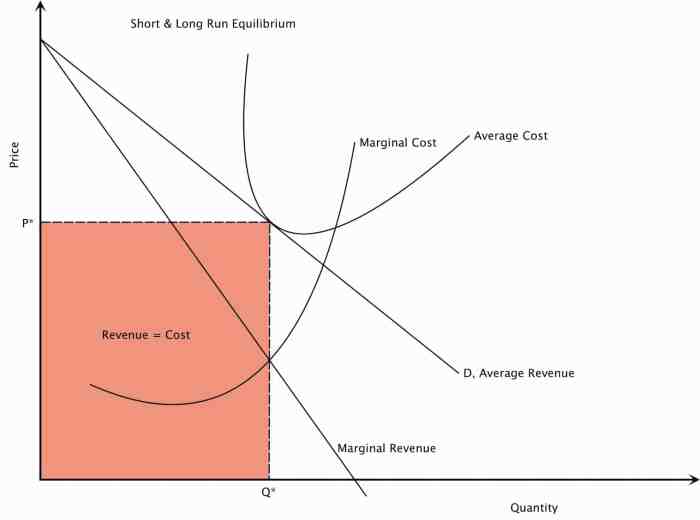At its profit-maximizing output a pure nondiscriminating monopolist achieves – At its profit-maximizing output, a pure nondiscriminating monopolist achieves a unique position in the market, characterized by the absence of price discrimination and the pursuit of maximizing profits. This distinctive market structure raises important questions about the behavior of monopolists, the welfare implications of their power, and the role of competition in shaping market outcomes.
This exploration will delve into the defining characteristics of a pure nondiscriminating monopolist, examining how they determine their profit-maximizing output level. We will analyze the relationship between price, output, and marginal revenue, shedding light on the pricing strategies employed by monopolists.
Furthermore, we will assess the welfare implications of monopoly power, considering the impact on consumer surplus, producer surplus, and overall economic efficiency.
Market Structure: At Its Profit-maximizing Output A Pure Nondiscriminating Monopolist Achieves

A pure nondiscriminating monopolist is a single seller in a market who has the power to set the price of its product. This power arises from the lack of competition in the market, either due to barriers to entry or the absence of close substitutes.
Monopolists face downward-sloping demand curves, meaning that they must lower their price to sell more output.
Profit-maximizing monopolists aim to produce the output level at which marginal revenue equals marginal cost. This is because producing more or less than this output level would result in lower profits. Monopolists have market power, which allows them to set prices above marginal cost and earn economic profits.
Output Level

Profit-maximizing output is the output level at which a monopolist earns the maximum possible profit. To determine this output level, monopolists compare marginal revenue and marginal cost. Marginal revenue is the change in total revenue resulting from selling one additional unit of output, while marginal cost is the change in total cost resulting from producing one additional unit of output.
Monopolists produce output up to the point where marginal revenue equals marginal cost. This is because producing more output would result in marginal revenue being less than marginal cost, leading to a decrease in profits. Similarly, producing less output would result in marginal revenue being greater than marginal cost, also leading to a decrease in profits.
Pricing Strategy

Profit-maximizing monopolists set their price above marginal cost. This is because they have market power and can restrict output to create scarcity, allowing them to charge a higher price than would be possible in a competitive market.
The relationship between price elasticity of demand and monopoly pricing is important. Price elasticity of demand measures the responsiveness of quantity demanded to changes in price. A monopolist with a more elastic demand curve will face a greater loss in revenue for a given price increase, and thus will set a lower price than a monopolist with a less elastic demand curve.
Monopolists may use price discrimination to maximize profits. Price discrimination involves charging different prices to different customers for the same product or service. This can be done by dividing customers into different groups based on their willingness to pay or other characteristics.
Welfare Implications

Monopoly power can have significant welfare implications. Consumer surplus is the difference between the price consumers are willing to pay for a product and the price they actually pay. Producer surplus is the difference between the price producers receive for a product and the cost of producing it.
Monopolists can reduce both consumer surplus and producer surplus. They restrict output below the competitive level, leading to higher prices and lower consumer surplus. Additionally, monopolists may earn economic profits, which reduces producer surplus for other firms in the market.
Overall, monopoly power can lead to market inefficiencies and reduced economic welfare. It can result in higher prices, lower output, and reduced consumer choice.
Essential FAQs
What is the key characteristic of a pure nondiscriminating monopolist?
A pure nondiscriminating monopolist charges a single price to all consumers, regardless of their individual demand.
How does a monopolist determine its profit-maximizing output level?
A monopolist sets its output level where marginal revenue equals marginal cost.
What are the welfare implications of monopoly power?
Monopoly power can lead to reduced consumer surplus, increased producer surplus, and overall market inefficiencies.